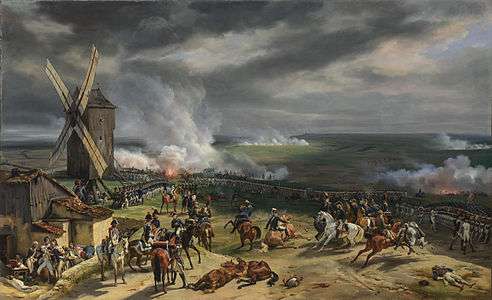Campaigns of 1792 in the French Revolutionary Wars
The French Revolutionary Wars began in 1792.
Preparations
France declared war on Austria on 20 April 1792. Prussia and other powers had allied themselves with Austria in the expectation of conflict, and thus France faced a coalition and not a single power at the moment when the emigration of nobles, the ferment of the Revolution, and want of materiel and funds had thoroughly disorganised her army.
The army performed poorly in the first engagements. Near Lille (29 April), French soldiers fled at sight of the Austrian outposts and murdered their general Théobald Dillon, whom they accused of treason. The commanders-in-chief of the armies became political "suspects"; and before a serious action had been fought, the three armies commanded respectively by Rochambeau, Lafayette and Luckner had been reorganized into two commanded by Dumouriez and Kellermann. Thus the disciplined soldiers of the Allies had apparently good reason to expect an easy campaign.
On the Rhine, a combined army of Prussians, Austrians, Hessians and French émigrés under the Duke of Brunswick was formed for the invasion of France, flanked by two smaller armies on its right and left, all three being under the supreme command of King Frederick William II of Prussia. In the Southern Netherlands, plans called for the Austrians to besiege Lille, and in the south the Piedmontese also took the field.
The first step was the issue (25 July) of the Brunswick Manifesto, a proclamation which, couched in terms most insulting to the French nation, generated the spirit that was afterwards to find expression in the "armed nation" of 1793–1794, and sealed the fate of King Louis. It was issued against the advice of Brunswick himself, whose signature appeared on it; the duke, a model sovereign in his own principality, sympathised with the constitutional side of the French Revolution, while as a soldier he had no confidence in the success of the enterprise.
Invasion

After completing its preparations in the leisurely manner of the previous generation, his army crossed the French frontier on 19 August 1792. The Allies readily captured Longwy and slowly marched on to Verdun, which appeared more indefensible even than Longwy. The commandant there, Colonel Beaurepaire, shot himself in despair, and the place surrendered on 3 September 1792.
Brunswick now began his march on Paris and approached the defiles of the Argonne. But Dumouriez, who had been training his raw troops at Valenciennes in constant small engagements, with the purpose of invading Belgium, now threw himself into the Argonne by a rapid and daring flank march, almost under the eyes of the Prussian advance guard, and barred the Paris road, summoning Kellermann to his assistance from Metz. Kellermann moved but slowly, and before he arrived the northern part of the line of defence had been forced. Dumouriez, undaunted, changed front so as to face north, with his right wing on the Argonne and his left stretching towards Châlons, and in this position Kellermann joined him at Sainte-Menehould on 19 September 1792.
Brunswick meanwhile had passed the northern defiles and had then swung round to cut off Dumouriez from Châlons. At the moment when the Prussian manoeuvre was nearly completed, Kellermann, commanding in Dumouriez's momentary absence, advanced his left wing and took up a position between Sainte-Menehould and Valmy. The result was the Cannonade of Valmy (20 September 1792). Kellermann’s infantry, nearly all regulars, stood steady. The French artillery justified its reputation as the best in Europe, and eventually, with no more than a half-hearted infantry attack, the duke broke off the action and retired.
This seemingly minor engagement proved the turning point of the campaign. Ten days later, without firing another shot, the invading army began its retreat. Dumouriez did not press the pursuit seriously; he occupied himself chiefly with a series of subtle and curious negotiations which, with the general advance of the French troops, brought about the complete withdrawal of the enemy from the soil of France.
Other fronts
Meanwhile, the French forces in the south had driven back the Piedmontese and had conquered Savoy and Nice.
Another French success was the daring expedition into Germany made by Custine from Alsace. Custine captured Mainz on 21 October 1792 and penetrated as far as Frankfurt.
In the north, the Austrian siege of Lille had completely failed, and Dumouriez now resumed his interrupted scheme for the invasion of the Netherlands. Controlling enormously superior forces, he made his advance late in the season and surprised the Austrians. On 6 November he won the first great victory of the war at Jemappes near Mons and, this time advancing boldly, he overran the whole country from Namur to Antwerp within a month.
Cultural representations
- The situation of 1792, and the feeling of dire threat felt by the invaded French, are reflected in large parts of the wording of the French anthem "La Marseillaise", written at the time: Against us, tyranny's/Bloody banner is raised./Do you hear in the countryside/Those ferocious soldiers roaring?/They come right into our bosom/To slit the throats of our sons, our wives!
- Custine's invasion of the German Palatinate forms the background for Goethe's Hermann and Dorothea, written a few years later. The epic poem's plot takes place in a small town near Mainz, flooded by refugees who fled their villages on the western side of the Rhine in order to seek refuge from the French troops on the eastern side.
Sources
- Original text from 1911 Encyclopædia Britannica
| Preceded by — |
French Revolutionary Wars 1792 |
Succeeded by 1793 |